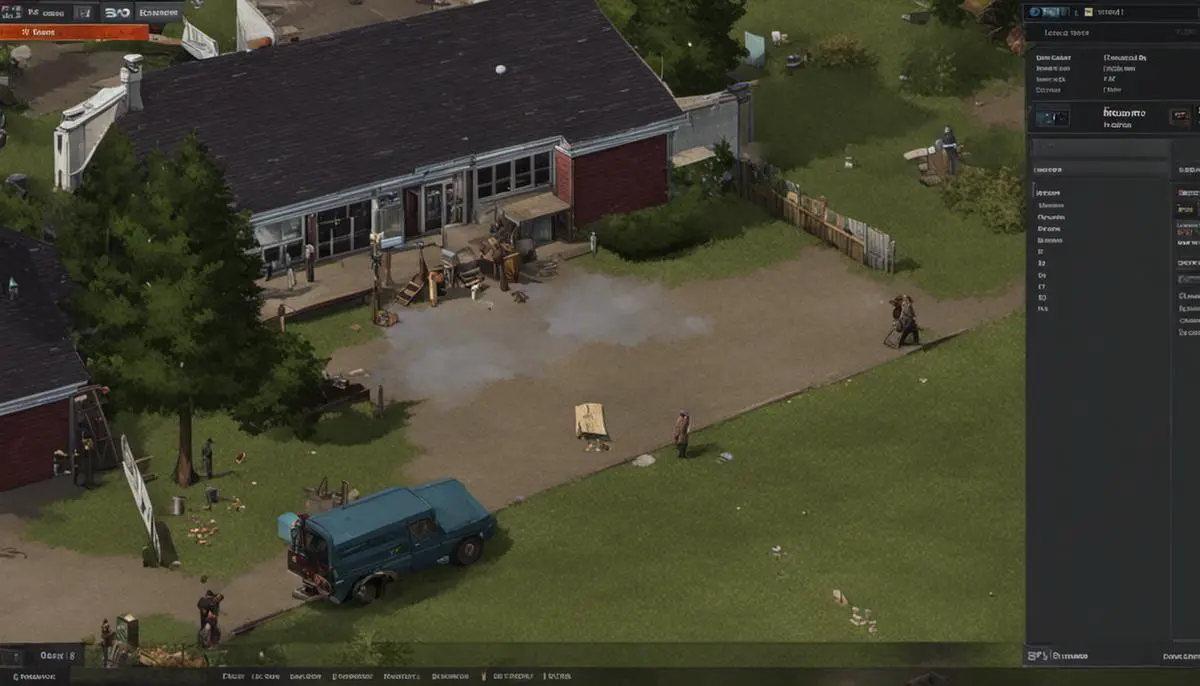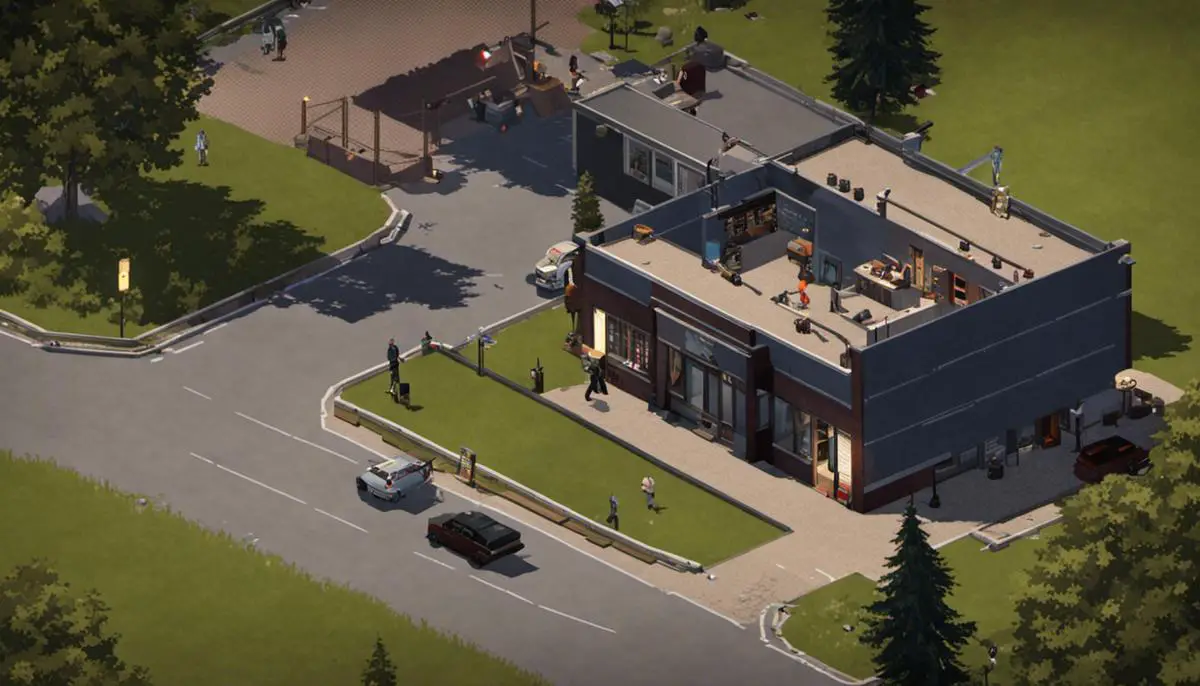Project Zomboid stands as a pinnacle of survival video gaming, inviting hundreds of thousands of players into its immersive post-apocalyptic world. The uniqueness of this game lies in its strikingly realistic mechanics, where each decision impacts your survival chances. This article provides a thorough exploration of Project Zomboid, its basic mechanics, and the distinctive elements that elevate your gaming experience. Moreover, we delve into the intriguing aspect of in-game cheats through Project Zomboid’s Debug Mode, guiding you through the process of accessing and activating these cheats, which can radically transform the game dynamics.
Understanding Project Zomboid
Unraveling Project Zomboid: A Deep Dive into Its Game Mechanics
Project Zomboid: a fascinatingly complex, ultra-realistic survival horror game, has been stirring up quite a discussion in the gaming fraternity. Enthusiasts are enthralled by the realistic details around survival skills, crafting, construction, and loot gathering, all against a backdrop of a zombie apocalypse. It’s high time to delve deeper into this one-of-a-kind gaming experience and comprehend its unique game mechanics.
Developed by The Indie Stone, Project Zomboid is set in an area affected by a zombie outbreak, where players are immersed in a sandbox survival challenge. The central objective is not just to survive, but also to understand how and when the inevitable death will occur, creating an intense, edge-of-the-seat playing atmosphere.
Featuring a captivating isometric 3D display, the game delivers an old-school vibe but is also acutely modern in its execution. Its mechanics, from developing player characters, crafting tools, to constructing a save haven, have an extremely impressive degree of depth and variation.
Intricate character building is a cornerstone of the game. At the onset, players have the liberty to construct their character, conveying natural abilities and impediments. This lays the groundwork for the approach a player adopts towards their survival strategy; whether it’s becoming an agile burglar or a strong farmer ultimately shapes the gameplay and experience.
The lynchpin of Project Zomboid’s gaming mechanics has to be its crafting and construction system. The game provides meticulous details running through the basics of crafting primitive tools to constructing a fortress against the undead hordes, all achieved through an intuitive crafting menu. Various resources can be scavenged across the expansive map, supporting a wide variety of crafting recipes.
“Realism” should be the game’s middle name. The game offers an in-depth look at survival situations, like the need for food and water, sleep, dealing with injury or illness, emotional well-being, and even warding off boredom – a reflection of everyday human norms that couldn’t have been better portrayed.
One of the game’s unique aspects is its moodle mechanic, a system integrated to give cues about the player’s condition. Red, orange, or yellow hues signpost anything from fever to hunger, extreme tiredness to hypothermia, providing a potent and immersive way for players to gauge their character’s health and well-being.
While Zomboid’s mechanics, like scavenging for supplies, battling zombies, or facing the harsh realities of survival, are notable, the game renders a visceral experience through its Permadeath system – the end of a player’s life means permanent game-over. It effectively intensifies the opportunities available, making decision-making a paramount and strategic part of the gameplay.
Project Zomboid, with its realistic sandbox zombie survival setting and deep game mechanics, offers an urbane, sophisticated take on the classic apocalyptic scenario. It flip-flops from sheer panic and chaos to an odd serene clarity when danger is temporarily at bay. Thus, making it a worthy addition to the library of any discerning early adopters of unique gaming experiences. This is not a game; it’s a test of survival abilities in the most unfathomably grim circumstances.
Though Project Zomboid might require an initial time investment to fully grasp its mechanics, the payoff comes in terms of the absolute realism and deep involvement elicited from the gameplay. With its detailed mechanics, engrossing character building, and progressive difficulty, it offers a hauntingly beautiful gaming experience through the lens of a zombie apocalypse, that’s worth every second.

Accessing Project Zomboid’s Debug Mode
Unleashing Project Zomboid’s Debug Mode – Unlock More, Play More
Project Zomboid shines a remarkably detailed light on the zombie apocalypse crafting, survival and decision-making dynamics. But, what if you could unlock even more? Well, with Debug Mode, that potential comes to life. Stepping into Debug Mode is your backstage pass granting access behind the scenes of this complex game. You can manipulate variables, experiment with settings, and explore facets of the game world unattainable in the standard playthrough.
So, how would a tech enthusiast adept at managing intricacies in technology enable and navigate Debug Mode in Project Zomboid? There’s no single tick-box; it requires an understanding of the game’s file structure and a courage to change a few lines of code.
First things first: locate your Zomboid folder. It is usually found inside the “%UserProfile%Zomboid” directory on Windows. Open it, and search for the ‘Options.ini’ file within. Use any text editor (Notepad or Notepad++) to open the file.
Next, you’ll want to change the Debug line of code. Stationed under [Debug], you’ll find a line labeled “DebugEnabled,” followed by “=false”. Strikingly, it identifies if the debug mode is activated or not. So, change “false” to “true”, save your alterations, and close the file.
Now, the fun begins. Start Project Zomboid, and voila! Debug mode is at your fingertips. Access it in your gameplay simply by hitting the F11 key. This will bring up a new menu with numerous options that enable you to adjust gameplay by tweaking the game’s behavior, spawning items, teleporting around the map, or controlling the weather. You can now experiment, troubleshoot, or enhance your gameplay experience as you wish.
A word of caution here, though. While liberating, Debug Mode also removes the challenge from the game, making it far less exciting than it is intended to be. For those seeking to maintain the thrill of playing Project Zomboid, it’s best to use Debug Mode sparingly and judiciously.
Unearthing the secrets of Debug Mode isn’t just about elevating your game experience. It’s about applying analytical thinking and taking an understanding of the game’s mechanics to another level. In the world of Project Zomboid, where death is imminent, who wouldn’t want to savor the satisfaction of tweaking the game’s framework — all the while testing the limits of survival in this post-apocalyptic nightmare?
So, navigate wisely, tech enthusiasts, and remember: Debug Mode is your game-changing weapon amid the apocalypse. Consider it your electronic toolbox, filled with tools that enhance gameplay, find glitches, or simply challenge your understanding of Project Zomboid’s intricate workings. After all, there’s more to the game than just surviving — as they say, the devil is in the details.

Activating Cheats in Project Zomboid
While mastering Project Zomboid requires investing in its intricate mechanics and meticulously detailed gameplay, many players often explore the possibility of using cheats to bend the game to their will. Admittedly, cheats provide an alternate perspective on the game, providing an aspect of control that the game’s survival horror setting usually doesn’t afford. However, it’s essential to remember that this exploratory chance shouldn’t be exploited, as it might compromise the genuine thrill Project Zomboid is revered for.
The primary gateway for using cheats in Project Zomboid is through its Debug Mode. Debug Mode, typically created for developers for testing purposes, offers a smorgasbord of options that allows players to manipulate various aspects of the game – change weather conditions, spawn items, teleport, and even transform into a superhuman. It is crucial to heed that Debug Mode is a double-edged sword – misuse can disrupt the immersive experience Project Zomboid meticulously crafts.
To enable Debug Mode, you must first locate the game’s Options.ini file. On Windows, this file can be found under the “Users/YOUR_USERNAME/Zomboid” directory. While on MacOS, head over to “Users/YOUR_USERNAME/Zomboid”. For Linux users, the file is under “/home/YOUR_USERNAME/Zomboid”.
Open the Options.ini file with a text editor such as Notepad or TextEdit. Within this file, near the bottom, find a line that says “Debug = false”. Change the “false” to “true”, save the file, then restart the game. Voila – Debug Mode is now activated! During gameplay press F11 to display the debug options overlay. While the appearance of these debug controls may disrupt Project Zomboid’s rooted immersion aesthetic, the variety of features it offers is uncannily fascinating.
Debug options are diverse – you can make your character invincible, invisible, even fly. Contrarily, you can impose some challenges by inducing immediate infection, spawning hordes, or summoning a helicopter to rile up the undead. Weapon and item spawning can come in handy to facilitate practices or to organize sessions of unorthodox gameplay scenarios. Toggling weather, environment, or NPCs allows players to create cinematic variety and diversify their experience.
However, the sheer potency of Debug Mode should warrant a word of caution. The ease to manipulate variables and gain advantages tampers with the fundamental charm of Project Zomboid. Every cheat, every unfair advantage taken, chips away at the thrilling survival challenge that the game is. One must tread this path with a disciplined motivation for experimental curiosity, not egoistic game domination.
Debug Mode is an intriguing auxiliary to Project Zomboid, significantly when used to both enhance gameplay and as a tool to help understand more complex game mechanics. Remember, the real charm of Project Zomboid lies in its gritty realism, the relentless threat of waning resources, and the looming dread of demise – the fun part, the human part, is seeing if you can survive against these odds. Debug Mode gives you god-like power, but even gods need an apocalypse.

Learning how to navigate Project Zomboid’s Debug Mode and activate cheats adds an extra layer of depth and excitement to the game. Mastering these aspects allows you to explore different play styles and situations, pushing the boundaries of what is possible within the game. Equipped with the knowledge provided, your gaming experience in the post-apocalyptic world of Project Zomboid can now transcend its usual confines, opening doors to unique scenarios and making each session more enjoyable and challenging.


